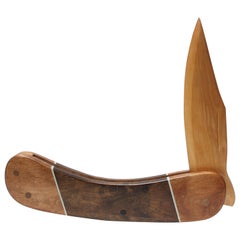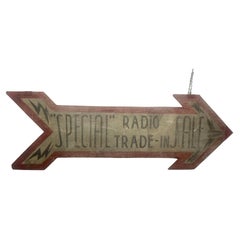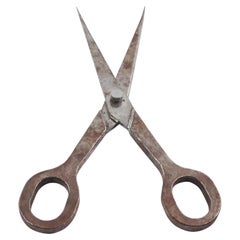Jarontiques Signs
1
to
1
1
1
1
1
1
1
1
1
1
1
1
1
Large Folk Art Pocket Knife Store Display
Located in Brooklyn, NY
One of a kind large scale pocket knife (24" L), likely used as a store display / sign composed of a painted and carved walnut handle / bolster wi...
Category
Vintage 1970s American Folk Art Sculptures and Carvings
Materials
Walnut, Poplar
Related Items
Large Hand Painted Double Sided Arrow "Radio Trade In" Folk Art Trade/Store Sign
Located in Buffalo, NY
Large Hand Painted, Double Sided Arrow "Special" Radio Trade In sale,,,,Folk Art Trade/Store Sign,,Wonderful size,,amazing crackle paint, patina..Great subject.
Category
Vintage 1930s American Folk Art Signs
Materials
Masonite, Paint
H 24 in W 62 in D 1 in
Folk Art Giant Metal Scissors Industrial Store Display Sign
Located in Atlanta, GA
This is an industrial metal store display sign that showcases French Folk Art. The sign boasts gigantic scissors, which can be used as an advertisement for a barber or hair salon. It is possible that the sign was originally used as a trade sign for a tailor shop or a millinery store. The sign is made of chromed metal and has the same maneuverability as real scissors. Despite being an outdoor sign...
Category
Mid-20th Century French Folk Art Signs
Materials
Metal, Chrome
Cigars Store / Trade Folk Art Wooden Carved Sign. c 1900
Located in Buenos Aires, Olivos
American Folk art wooden "CIGARS" sign from the 1920's.
Great old Store Trade sign. Wood cut to cigar shape. Lettered in Gold Paint.
In good conditions, it was a in doors sign. Perfect for any cigar smoker.
Cigars History:
A cigar is basically dried tobacco leaves that are rolled and wrapped by other tobacco leaves in order to give you a full tobacco smoking experience.
Cigars are becoming more popular all around the world recently because they are exposed to a pop culture where a lot of famous people like Michael Jordan and Arnold Schwarzenegger smoke them.
In order to understand why cigars have become very well-known, we need to take a good look at their history and where they came from. That way, we can truly understand this pop phenomenon. Here is a brief history of cigars.
Origin of Cigars
The exact origin of cigars is not entirely known but historians believe that cigars were first invented by the ancient Mayans.
The ancient Mayans would collect tobacco leaves and wrap them up in a plantain leave in order to smoke it. An ancient Mayan pot...
Category
Early 20th Century American Folk Art Signs
Materials
Wood
Oversized Bonze Advertising Store Display Scissors
Located in Brooklyn, NY
Midcentury, oversized, advertising, store display, bronze scissors open and close as real scissors. Makes a great, rustic, folk art piece or wall art.
Category
Mid-20th Century American Industrial Signs
Materials
Bronze
“Giant” Scissors, Advertising Store Display
Located in Philadelphia, PA
Cast aluminum oversized scissors
probably used for advertising and or store display.
These will add interest to any room, wall, hair salon or fash...
Category
Vintage 1960s American Mid-Century Modern Signs
Materials
Aluminum
Hellesens Advertising Pocket Knife
By Stocker
Located in East Geelong, VIC
Designed as a copy of their dry cell battery, this Hellesens advertising pocket knife measures 49 mm (2 inches) in length, is 17 mm (2/3 rds of an inch) w...
Category
Vintage 1930s German Signs
Materials
Steel
Oversized Advertising Store Display Scissors
By Claes Oldenburg
Located in Philadelphia, PA
Brass oversized scissors
probably used for advertising and or store display.
These will add interest to any room, wall, hair salon or fashion fashi...
Category
Vintage 1960s American Folk Art Signs
Materials
Brass
Store Display Boy Doll, Child Mannequin
Located in Antwerp, BE
Art Deco store display boy - store display doll - child mannequin doll.
This antique child mannequin is a male child.
He has a painted plaster body, painted eyes and a painted wooden base. This store display advertising doll is probably designed for a clothing line which was located in Holland - The Netherlands.
This vintage store display - shop window doll - advertising doll - vintage mannequin doll is for the age still in very beautiful condition. He does have an old repair on a finger and on 1 foot.
This boy mannequin doll will look great in your interior as a decorative object or in a collection of dolls and bears, antique mannequin dolls.
Category
Mid-20th Century Dutch Art Deco Toys and Dolls
Materials
Plaster, Wood
Early 20th Century Double Sided French Zinc Clock Smiths Trade Sign
Located in London, GB
Early 20th century double sided French zinc clock Smiths Trade sign
We are proud to offer a rare example of an early 20th century French double sided clock smiths trade sign. With i...
Category
Vintage 1910s French Victorian Signs
Materials
Zinc
19th Century Chinese Restaurant Hand Carved Trade Sign of Fish
Located in Hamilton, Ontario
19th century Chinese restaurant hand carved trade sign of fish.
Category
Antique 19th Century Signs
Materials
Wood
Wooden Phrenology Head Advertising Store Display Model Folk Art Americana
Located in Buenos Aires, Olivos
Carved and painted wooden phrenology head Store display advertising model. Phrenology bust by unknown wood carver, circa 1870. Perfect to decorate a Do...
Category
Antique Late 19th Century American American Craftsman Sculptures and Car...
Materials
Wood
Late 17th/Early 18th Century Polychrome Tobacconist Figure Sign Folk Art Carving
Located in Lowestoft, GB
A large carved and polychrome painted tobacconist's figure almost certainly 17th or early 18th century
For a related example see Edward H. Pinto, Treen and other Wooden Bygones, Bell and Hyman, London 1969. Page 412, plate 436.
Originally this may well have been a tobacconist's shop window figure. For a similar, but slightly earlier unpainted example, see Sotheby's, The W. J. Shepherd collection of treen, 30th November 1983, Lot 393, illustrated in Pinto "Wooden Bygones of Smoking and Snuff Taking", plate 1.
Carved wooden figures, often painted, were placed outside tobacconist's shops as signs from the 17th century onwards. The earliest of these figures is the 'black boy' or 'blackamoor'. 'At the sign of the black boy' or 'at the sign of the blackamoor' was a popular address for tobacconists since the early 17th century. The 17th century figures...
Category
Antique 17th Century English Sculptures and Carvings
Materials
Pine
H 35.83 in Dm 14.97 in


